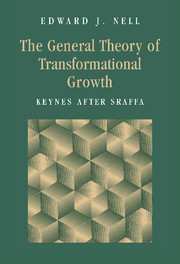Book contents
- Frontmatter
- Contents
- Preface
- Acknowledgments
- Part I History or equilibrium?
- Part II Method and approach: the active mind
- Part III Money and the Golden Rule
- PART IV The wage-profit trade-off
- Part V Investment and Mass Production
- 10 Demand growth, pricing, and investment plans
- 11 Inflation, employment, and market adjustment in Mass Production
- Part VI Money and fluctuations in the modern economy
- Conclusions
- Bibliography
- Index
10 - Demand growth, pricing, and investment plans
Published online by Cambridge University Press: 21 January 2010
- Frontmatter
- Contents
- Preface
- Acknowledgments
- Part I History or equilibrium?
- Part II Method and approach: the active mind
- Part III Money and the Golden Rule
- PART IV The wage-profit trade-off
- Part V Investment and Mass Production
- 10 Demand growth, pricing, and investment plans
- 11 Inflation, employment, and market adjustment in Mass Production
- Part VI Money and fluctuations in the modern economy
- Conclusions
- Bibliography
- Index
Summary
In Craft-based economies investment will tend to be “regular,” that is, to be governed by the growth of the labor force, which itself is the result of the structural tendency of labor to be released from agriculture and flow from the countryside to urban areas (Nell, 1992). Growth takes place through the establishment of new firms on borrowed or entrepreneurial capital, so the rate of interest imposes a tendency to uniformity of the profit rate. Thus we saw that investment in Craft economies could be broadly described as supply-driven, that is, governed by the natural rate. But in Mass Production economies investment will be governed by technical progress and the expected growth of demand; investment will not be “regular,” and, moreover, the growth of demand will be influenced by the pricing policies adopted in the course of investment planning. Financial markets will encourage seeking out the highest profit rate, but any tendency to uniformity will be weak, because growth in different markets will be different.
Prices and investment plans will therefore be determined together, in the light of expected growth. These will be “benchmark” prices and will serve as guidelines to current behavior; however, there are good reasons for market prices to stay fairly close to the benchmarks.
Market adjustment under Mass Production will take a different course than in Craft economies.
- Type
- Chapter
- Information
- The General Theory of Transformational GrowthKeynes after Sraffa, pp. 467 - 544Publisher: Cambridge University PressPrint publication year: 1998



